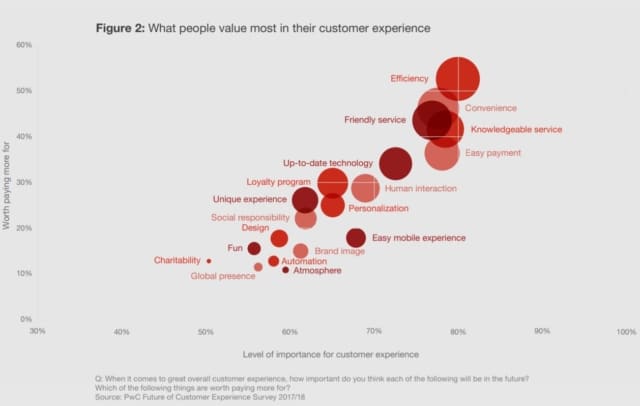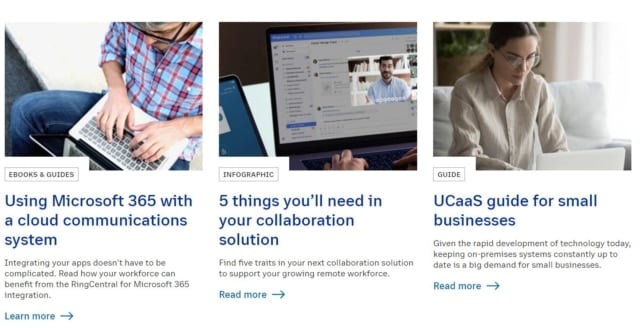Great customer service is at the heart of running a great business. Your product quality can be exceptional, but if you’re driving customers away with unfriendly or unhelpful service you’ll find yourself at the mercy of increasingly high churn rates.
Excellent customer service can be the basis of brand loyalty and advocacy, as well as overall retention rates. It even affects your bottom line. The ROI of customer experience is exceptionally high compared to other business focuses. You can measure this kind of ROI by looking at certain metrics, including customer retention over both transactional and subscription-based interactions.
What is “good customer service”?
Excellent customer service relies on a few central tenets, and is a surefire way of improving customer loyalty. A good customer service strategy draws together these ideas to keep customer needs in mind and address issues in real-time.
Quick response times, efficiency, and efficacy
Customer expectations are at an all-time high. With ecommerce increasingly on the rise, consumers have more choice than ever before. This means that they can choose to switch brands at a moment’s notice.
One of the highest-ranking factors customers look for when considering their position on a brand experience? Perhaps surprisingly, it’s customer service efficiency (above product quality and price). Customers’ time is valuable, and first-time resolution rates mean that they don’t spend endless hours trying to solve their problem and getting increasingly frustrated.
Whether you’ve been contacted via email or call, quick response rates are vital. Not only do they reduce frustration, but they also let your customer know that you care about them.
If your customer service rep hasn’t managed to resolve the issue within the first interaction, it’s particularly important to follow up. Nobody likes to feel abandoned! As soon as you have a fix in mind, let your customer know. And ideally, if it’s taking a while to get things sorted, it can’t hurt to keep them updated along the way as well.
When talking about efficiency, we have to mention the rise of chatbots in ecommerce. By utilising artificial intelligence, these bots can communicate with customers on your behalf, providing useful information pulled from previous interactions.
However, two other factors that rate highly are human interaction and knowledgeability. This suggests that whilst chatbots can be helpful in some aspects, human customer service representatives still have a place.
While bots can play a role in targeting problems before they snowball, humans can be useful to help address tougher issues and to empathise when things have gone wrong.

Listening to customer feedback
Customer service means solving problems, but it also means proactively taking steps to ensure those problems don’t arise in the first place for future customers.
This is a crucial facet of customer support, which is typically employed in more technical sectors where customers are likely to have intricate problems that they need help with.
In customer support teams, it’s not unusual to report back regularly to product development teams to ensure that these problems get ironed out in subsequent releases.
However, this kind of feedback can be useful across all industries. If a certain issue keeps coming up again and again, it’s a good idea to address it and save customers the hassle in the first place.
Perhaps that might involve updating your FAQ section to answer a common question, or making your website more accessible for all users. It might even be an operational or logistics issue like reducing (or scrapping) shipping fees or using a more reliable courier.
Either way, once the solution is in place, your customer service team will be freed up and able to focus on other matters.
Employing customer success techniques
Talking of updating that FAQ section, there’s another area of customer service that is often overlooked: Enabling customer success.
Customer success allows people to solve their issues without contacting the company at all – it’s a kind of self-service option.
Comprehensive FAQs and a solid, accessible knowledge base is only the beginning when it comes to customer success. Because it’s mostly used in SaaS industries, it can involve efficient onboarding as well as technical troubleshooting and resource centres.
That isn’t to say it isn’t useful across the board, though: Allowing your customers to access self-service resources means that there is no room for bad customer service interactions.

Accessibility over all channels
While some problems might be best solved over a quick phone call, many customers nowadays prefer to use other methods of communication.
It’s essential to remember that your customers are real people who may not have time to sit around waiting for a phone call, which means that having omnichannel customer support available is one simple way to make a customer feel respected.
Social media is one easy way to chat with customers, especially because it can allow real-time support. Incorporating AI or chatbots into your site can also provide quality customer service through its speedy response time.
Using this method also means that the bot can answer common retail customer questions, leaving your support team free to deal with any more complicated issues that come up, and reducing wait times.
Meanwhile, a report by Kayako suggests that 52% of consumers are more likely to stay loyal to a brand that uses live chat.
You can also set up a virtual contact centre that enables your customer service representatives to help from anywhere in the world, and with multiple channels at their fingertips.
Most common characteristics of good customer service teams
Some recurring themes come up when looking at customer service teams that are excelling.
Some of these are soft skills, which can be cultivated within teams to improve their efficacy.
When recruiting, try to ask interview questions which draw out the capacity for these features and skills. Alternatively, enhance your customer service team with courses on these soft skills that could make the entire team run more smoothly.
On the other hand, some of these rely on company culture and the freedom to work in the way that works best for customers.

Communication – with customers and with one another
One of the most crucial things that comes up time and time again is the importance of communication.
Customers must be kept in the loop throughout their journey with your brand – whether it’s details about shipping or (god forbid) a data breach.
In fact, 44% of consumers think that “transparency and quick action after a [data] breach” is the most important factor in whether they would continue to do business with that brand – even as they believe that data breaches themselves are almost inevitable.
Communication plays a huge part in that transparency. Whether it’s a quick email update or a follow-up phone call, letting customers know that you’re thinking of their needs is a surefire way to reduce any complaints.
It’s not just a useful tool when it comes to negative events, either. Letting your customers know when their order has shipped can be an excellent opportunity to amp them up about their new purchase and potentially upsell.
Follow-up emails in the days after they receive their product can be both an excellent source of constructive feedback and a way to enable customer success, too. Perhaps pointing out common stumbling blocks and explaining how to get over them, for instance, could delight some customers.
So, the ability to communicate clearly and concisely with customers can play a large role in customer service. But it’s also important that staff can openly and honestly communicate with other team members. This can lead to enhanced collaboration and (if they’re not worried about speaking up in front of senior stakeholders) to real change.
And if your teams are all remote? There are plenty of online collaboration tools to choose from.

Proactivity
Rather than waiting for small problems to spiral into big issues, or waiting for a specific request from the customer, a proactive customer service response is generally what marks out excellent customer experiences from mediocre ones.
If your customer service representative has the autonomy to make decisions on a case-by-case basis, you might find yourself with a growing base of loyal customers.
For example, having received a complaint about a product that arrived broken, your customer service rep could just send out a new product with a quick, generic apology email.
Alternatively, they could send a replacement product with a complimentary item included in the package as well – possibly alongside a handwritten note explaining how the items work together and apologising for the inconvenience.
They’re not hugely different in the amount of effort required, but one marks your company out as exceptional and is likely to garner you a positive reputation as word spreads.
Obviously, alongside proactive employees, you do need to give them the freedom to make these decisions. In one notable case that we’ll talk about later, employees are authorised to spend up to $2000 per day to improve client experience.
While that is an unattainable goal for most businesses, it’s that willingness to make the customer experience exceptional that creates some brands’ fame.
Providing feedback
One of the best things to look out for and nurture within customer service teams is the ability to collate data and provide concise feedback to other departments.
While bad customer service can stem from unmotivated employees or inflexible policies, it can just as easily be a result of the team being unable to enact change. These changes might well be what your company needs to succeed long-term, and who is better placed to hear all about how to improve?
Customers who have had a bad experience with the brand won’t necessarily want to spend an age helping you to make tweaks to your product offering. In initial complaints, you have a goldmine of information: What’s working and what isn’t.
You’ll see this dynamic within customer support teams, who are often given the power to present ideas to product development or marketing teams that affect the brand. But it’s a skill that can be useful throughout customer service – so a culture that welcomes feedback in all forms is a must.

The personal touch
Though efficiency and convenience came top in PwC’s customer experience ranking, following not far behind are personalisation and human interaction.
As customer satisfaction should be at the heart of every customer service exchange, it’s a great time to play to those values and show off the brand’s human side.
Part of this involves your customer service reps having the autonomy to make quick decisions alone.
But even if that’s not possible, you can incorporate some human touches into your customer service. Handwritten notes or even emails written on a per-case basis rather than using generic templates can both show customers you truly care about their conundrum.
Further, if you can centralise a database of complaints and recall any previous interactions you’ve had with individuals, you can prevent them from having to repeat themselves. This works especially well if you can pull it off across channels – it’s part of what makes an omnichannel approach seem so fluid.
Skills for good customer service
Whilst there’s something to be said for hiring a varied range of reps, there are some customer service skills that are pretty much universally helpful.
Positivity
Anyone who has been in a customer-facing role can tell you that staying positive (especially when you’re being blamed for something that’s nothing to do with you) can be a challenge.
That said, a positive outlook and the ability to stay calm in the face of irritation can go a long way.
It enables your customer service representatives to offer their best service – ideally, one that prevents customers from getting more worked up than they already are. It can also often deescalate the situation. We all know that antagonising people with snark isn’t the best way to build customer loyalty.
Positivity is a bonus even when customers are being perfectly reasonable: It’s much more pleasant to interact with someone courteous and open to finding solutions than it is with one who is quite clearly only there for the paycheck.
Problem-solving
Similarly, the best customer service relies heavily on problem-solving. In dealing with everyday tickets this might not come up a lot, but there will be plenty of issues that just haven’t arisen in the past.
Plus, as we’ve already noted, the recurring problems might be better addressed with a more permanent solution.
In both of these instances, problem-solving is key. Whether they’re walking someone through a complicated tech update or offering assistance with a missing parcel, customer service reps have to be able to think on their feet – especially if they’re working in real-time.

5 examples of good customer service
We’ve all heard some bad customer service stories, but what about the real-life examples of exceptional customer service that left happy customers in their wake?
The following brands go the extra mile to properly address their customer’s needs, and we could all learn something from them, even if we don’t have quite the same resources available to us.
Zappos
Famously “customer service obsessed”, Zappos have made a name for themselves excelling in the customer experience. The online shoe retailer has grown from humble origins, and now wants to be known as a service company that just happens to sell all sorts of things as well.
They even have a name for it: personal emotional connection (PEC). Employees are allowed to connect with customers however they see fit: Writing letters thanking people for ordering and recommending pizza places are just two of the ways in which Zappos’ customer service team have made a name for themselves.
Waitrose & Partners
British staple Waitrose & Partners have been around for over a century and in that time, they’ve built a name for themselves in customer service.
Part of that is in how they empower their employees. They even famously don’t call them that; they’re company Partners. Keeping their employees happy boosts positivity and leads to more constructive customer service interactions.
Besides, Waitrose & Partners were able to boost communication between employees, which has changed not only how they work with each other, but even how quickly they’re able to help customers.
Patch Plants
A newcomer to the scene of houseplants, Patch Plants spotted a gap in the market: A younger generation of plant-lovers who wouldn’t necessarily have either a garden or any gardening experience.
They used this to their advantage and ramped up their customer service and CRM offerings. When you sign up to emails, you receive tips and tricks on caring for plants and which ones to buy. Whenever a plant is bought, it comes with a set of emails detailing potential problems and their simple cures, as well as a tailor-made plant-care guide for best-sellers.
These emails not only prevent unnecessary returns from people who just don’t understand how to care for their plant, but also provide a great opportunity to keep interacting with customers.
The proactivity of sending the emails before the problems arise means that their customer service team is free to deal with more pressing issues.
Amazon
Amazon is famous not only for their super-speedy delivery but also their returns policy. In it, most sales made can be returned for refunds within 30 days.
Notably, they also have a very comprehensive FAQs section: You can find any and all information about returning things to Amazon without ever having to contact an employee. Whether you’re after information on how long your refund will take to arrive or on whether you can return customised goods, they have an easy-to-find section for it.
The Ritz-Carlton Hotel Company
With establishments all over the world, the Ritz-Carlton Hotel Company has certainly made a name for itself as the pinnacle of excellent customer service.
The hotel chain infamously allows its employees to spend up to $2000 per day on anything that will improve the customer experience.
According to one famous tale, a stuffed toy was left in one of the rooms, and the distraught child’s father Chris told him that the giraffe (Joshie) was just holidaying an extra few days.
After calling the staff at the Ritz-Carlton to ask that they send Joshie back home, Chris mentioned what he had told his son, and the hotel’s customer service team got to work.
They sent Joshie back complete with pictures of him enjoying his stay – lounging by the pool, helping out behind the scenes, and even enjoying a relaxing massage.
It would have cost minutes and a few pennies extra to send the photos, but it ensured that Chris and his son both remember the experience for life.

Best practices for speedy customer service
There are several ways in which you can speed up your customer service offering.
One of the best ways is to use technology that really works for your company. It might be that a messaging app would enable your customer service team to respond efficiently to customer queries in real-time, without having to check emails.
Similarly, utilising automation could help, though be careful to create the right balance between automated solutions and the personal touch of human customer service representatives.
Another option is to integrate customer service with other operations like CRM, product development, and marketing. Creating a culture of feedback means that your overall brand offering will improve, and customers will have fewer problems in the first place. This will free up reps who would otherwise have been caught in a cycle of solving repetitive issues, and so lessen queue times.
Conclusion
There are plenty of ways to deliver excellent customer service, but the takeaway here is that there are some core principles that can be applied universally.
Requirements will change depending on your industry and your customer’s needs, but the central tenets of efficiency, listening to feedback, and the importance of omnichannel accessibility remain the same.
It’s important to have a well-trained customer service team who are not only hand-picked for skills like problem-solving, but also nurtured to ensure they remain motivated and enthusiastic about the company.
They’re often the first actual interaction a customer has with your company, and their knowledge and passion for the product or service should shine through in every interaction. They need to be empowered not only to grow within the company but also to make autonomous decisions that improve customer experience.
Originally published Sep 13, 2021

